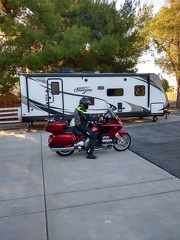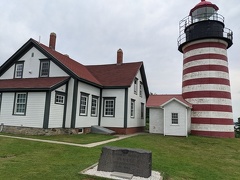
I was hoping that we would tour PEI and Nova Scotia by motorcycle in the summer of 2021 but COVID interfered. No entry was possible into Canada. So instead, we road to the New England states to visit family and stopped at many museums along the way.
Our initial target was Great Falls Montana to attend the BMW MOA Rally—an annual national event we've been to many times in the past. In the days leading up to the trip, we spent more than our typical time preparing and packing. There is a lot to consider when packing two people into the limited space on a motorcycle for a nearly two month long trip. When launch day finally arrived, we were up early in the cool morning twilight, quickly dressed for cool riding, rolled out the already loaded bike and hit the starter ... to hear a click and nothing more. Dead battery! Hard to understand why but there was no doubt. The battery had so little voltage that the lights would only illuminate dimly and the instruments computer(s) would not initialize.
After taking all the warm riding gear back off and hooking up the battery charger, we waited. After 30 minutes of charging it became clear that hours would be required to get the battery to a state able to start the bike. A growing desire, bordering on desperate determination, to get going lead to rolling another motorcycle out of the garage and deploying motorcycle sized jumper cables between the bikes. That did the trick! Bike started. After a few minutes of run time we had a battery able to re-start the bike. Knowing that hours of highway riding was ahead of us, which would provide plenty of charge time, I was confident that the battery would be able to start the bike after our next stop. Off we went only an hour delayed. The battery never did give us any trouble throughout the trip.
As is typical, arriving in Great Falls four days later meant greeting about 5,000 mostly BMW motorcycles in one little Montana town. Amazing to see! We stayed there about four days before heading east.
For this trip, we had a special focus on areas we had not previously explored by motorcycle. That included slowing down to spend time around the Great Lakes area where we visited all five lakes. Interesting stops included the Lake Superior Railroad Museum, Rider Warehouse, Richard Bong WWII Center, Great Lakes Shipwreck Museum, Soo Locks, crossing the Mackinac Bridge, and The Henry Ford.

Then, off to New England. Crossing New York State (NYS) provided enjoyable stops like Old Fort Niagara, Watkins Glen, Bridge Street1 (of It's A Wonderful Life fame) in Seneca Falls, overnight in Lincklaen House, RPI, and Fort William Henry, before crossing into Vermont. In New Hampshire and Maine we enjoyed quite a few new spots including the Washington Mt Cog Railway, West Quoddy Head Light Station (the eastern most point in the USA), Acadia National Park, Seal Cove Auto Museum (a rare find!), and LL Bean.
Riding down through Massachusetts and Connecticut took us to a visit on the Nautilus submarine in Connecticut. A ferry then transported us, and the bikes, to Long Island in NYS to visit Bryan. After a number of days riding back roads in NYS and visiting Scott, Dean, David, and Ralph, we were off to a special day spent touring the US Air Force Museum in Ohio. Then, a few days stay in Tennessee at Les' new place got us going back west. A relatively rapid trip across the western states delivered us back home to California.
Here is the resulting route and the many pictures we collected along the way. In total, the trip was just less than 10,000 miles covered in about six weeks.
1 Another more than coincidental similarity between Bedford Falls in the movie It’s A Wonderful Life and Seneca Falls is the story of Antonio Varacalli. On April 12, 1917, Antonio Varacalli drowned while successfully rescuing a young woman from the Seneca-Cayuga Branch of the Barge Canal a young woman who was apparently trying to commit suicide. Antonio, who was a Barge Canal worker, was walking in the vicinity of the bridge when he heard someone scream. He ran to the canal bank and saw a young woman struggling in the water. Without hesitation, he jumped into the canal to save the young woman, although he could not swim. He managed to get the girl to the canal bank before he sank into the water, and drowned. The death certificate states that he was pronounced dead at 11 A.M. and that he “drowned while attempting to rescue another person.” Antonio was age 17 at the time of his death and had been living at 16 Rumsey Street in the village. The young woman’s name was Ruth Dunham. (Apparently, Antonio had lied about his age so that he would be able to get a job. Using the age he had given at the time he was first employed, he would have been 22 at the time of his death. The death certificate apparently incorrectly lists 1895 as the year of his birth.)↵